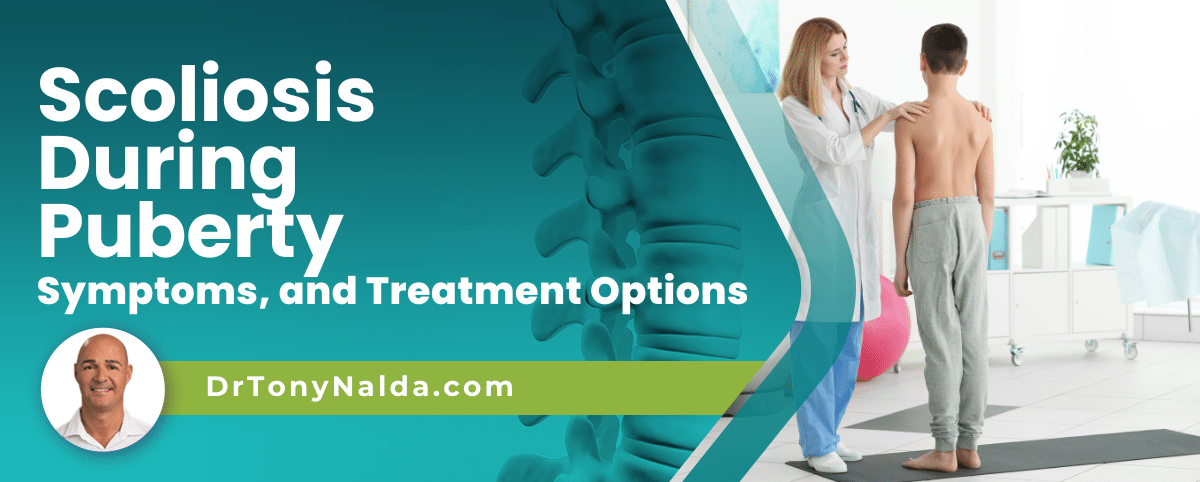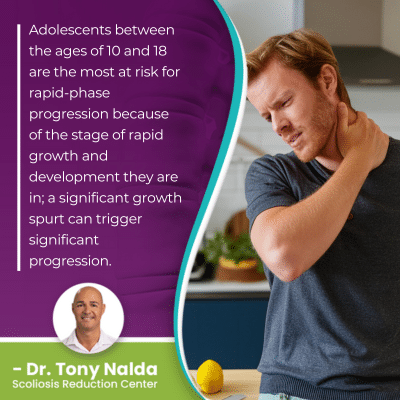Scoliosis During Puberty: Symptoms, and Treatment Options

It's important for parents, caregivers, and adolescents themselves to understand the progressive nature of scoliosis. Progressive conditions are virtually guaranteed to get worse over time, and as scoliosis progresses, its effects become more overt, and in children, these involve changes to posture and movement.
Scoliosis can affect all ages, but the age group most commonly affected are adolescents between the ages of 10 and 18: adolescent idiopathic scoliosis. Symptoms of scoliosis are more obvious during puberty because of growth triggering progression. Common signs include uneven shoulders and hips.
Scoliosis during puberty needs to be taken seriously because of the potential for rapid growth to trigger rapid progression.
Table of Contents
Diagnosing Adolescent Idiopathic Scoliosis
Scoliosis causes the development of an unnatural spinal curve that bends to the side, and in order to be considered a true scoliosis, there has to be a rotational component, meaning the spine also twists from front to back, back to front.
Scoliosis is a highly prevalent condition with close to seven million people living with it in the United States alone, and as the leading spinal condition among school-aged children, awareness of scoliosis during puberty is key.
There was a time when mandatory scoliosis screening was performed by school nurses across the States, but that has since changed, shifting the onus of early detection onto parents, caregivers, and patients themselves.
There are no treatment guarantees, but particularly when it comes to treating scoliosis during puberty, there are a number of benefits associated with early detection and intervention, mainly working towards counteracting the condition's progressive nature.
 Adolescents between the ages of 10 and 18 are the most at risk for rapid-phase progression because of the stage of rapid growth and development they are in; a significant growth spurt can trigger significant progression.
Adolescents between the ages of 10 and 18 are the most at risk for rapid-phase progression because of the stage of rapid growth and development they are in; a significant growth spurt can trigger significant progression.
Diagnosing adolescent idiopathic scoliosis involves a physical examination that includes taking the patient's family history and medical history, examining the spine when in a forward bend position, and ordering a scoliosis X-ray to truly see what's happening in and around the spine, to confirm a rotational component, and to determine the patient's Cobb angle measurement; a minimum Cobb angle of 10 degrees is needed to be considered scoliosis.
Cobb Angle and Condition Severity
When it comes to a patient's Cobb angle, this is how conditions are classified by severity, and treatment plans are shaped around key condition variables like condition severity.
A patient's Cobb angle is determined by drawing lines from the tops and bottoms of the curve's most-tilted vertebrae at its apex, and the resulting angle is expressed in degrees.
The more unnaturally tilted the vertebrae are, the larger the unnatural curve is, and the more severe the condition:
Mild scoliosis is diagnosed with Cobb angle measurements of between 10 and 25 degrees.
Moderate scoliosis is diagnosed with Cobb angle measurements of between 25 and 40 degrees.
Severe scoliosis curves are 40+ degrees, and very severe curves are 80+ degrees.
The more severe an adolescent's scoliosis is, the more likely it is to continue progressing, and the more noticeable its symptoms will be.
Symptoms of Scoliosis During Puberty
The symptoms of scoliosis during puberty can be mild, particularly in mild cases, and as scoliosis isn't commonly painful for children, this can be a barrier to early detection.
Scoliosis doesn't become a compressive condition until skeletal maturity has been reached, and it's compression of the spine and its surrounding muscles and nerves that causes the majority of condition-related pain; for adults, back pain and pain that radiates into the extremities due to nerve compression is the main scoliosis symptom.
Symptoms of scoliosis during puberty, however, can escalate quickly because it's growth that triggers progression, and progression makes scoliosis more overt.
Scoliosis is an asymmetrical condition; it introduces a lot of uneven forces to the body that disrupt its overall symmetry, and in many cases, the earliest signs of scoliosis during puberty are uneven shoulders and hips.
Additional postural changes can include:
- The head being uncentered over the torso
- An uneven eyeline
- Uneven shoulder blades
- Development of a rib cage arch
- An uneven waistline
- Arms not hanging at equal lengths
- One leg being shorter than the other (leg length discrepancy)
As the body's symmetry and posture are disrupted, changes to movement are also common including disruptions to balance, coordination, and gait.
Now, if scoliosis is left untreated during puberty, curves can continue to progress unimpeded, complications can develop, and invasive surgical treatment can be needed in the future.
Adolescent Idiopathic scoliosis Treatment Options
 When an adolescent is diagnosed with scoliosis, it's not easy to hear, particularly for an age group known for feelings of insecurity and self-consciousness; add onto that the pressures of social media to have the perfect body and life, and teens diagnosed with a progressive incurable spinal condition are facing a lot.
When an adolescent is diagnosed with scoliosis, it's not easy to hear, particularly for an age group known for feelings of insecurity and self-consciousness; add onto that the pressures of social media to have the perfect body and life, and teens diagnosed with a progressive incurable spinal condition are facing a lot.
While it's hard for young patients to hear that their scoliosis is incurable, I explain that it can be highly treatable, and there are a number of famous celebrities and professional athletes that have gone on to fulfill their life's goals, despite being diagnosed with scoliosis.
Scoliosis patients going through puberty are going through growth spurts that can make their symptoms increase quickly, and this can give the appearance of scoliosis developing overnight, but what it actually is is that enough progression has occurred over time to make the condition more noticeable.
So where a young patient's scoliosis is at the time of diagnosis doesn't necessarily reflect when it';s developed, but more so when it has progressed enough to become noticeable; this is why most of my patients are diagnosed with moderate scoliosis.
Treatment options for adolescents involve spinal fusion surgery or nonsurgical conservative treatment; let's discuss the pros and cons of each.
Spinal Fusion Surgery
Spinal fusion surgery is a costly, invasive, and risky procedure, and what I want patients and their families to be aware of is that many cases of scoliosis don't need a surgical procedure.
Scoliosis treated with surgery affects long-term spinal health and function differently.
Spinal fusion involves removing discs sitting between the curve's most-tilted vertebrae, fusing the vertebrae together into one solid bone, and attaching metal rods to the spine to hold it in place, and this eliminates movement in the area so the spine can't become more unnaturally curved over time.
However, fusing the spine is contrary to its natural movement-based design, so fused spines are commonly rigid with a reduced range of motion, and this can cause activity restrictions, increased pain at the fusion site, and affect a person's quality of life.
In addition, a spine that's fused is weaker and more vulnerable to injury.
So while spinal fusion can straighten a bent spine and address curve progression, the way it does so can cost the spine and patient in other ways, and remember, the younger a patient is at the time of the fusion, the longer the hardware has to last, and hardware malfunction over time is a risk.
Nonsurgical Conservative Treatment
Here at the Scoliosis Reduction Center, my patients benefit from a proactive conservative treatment approach that's started as close to the time of diagnosis as possible.
As how much growth a patient has yet to go through determines how much potential progression they can go through, childhood scoliosis should always be taken seriously.
Mild curves are simpler to treat than moderate curves, and larger curves greater than 40 degrees are considered severe and are likely to continue progressing, especially without proactive treatment.
While the exact causes of adolescent idiopathic scoliosis are unknown, we understand that as a child grows, they are at risk for progression, so working towards counteracting the condition's progressive nature, despite the constant progressive trigger of growth, is a focus of treatment.
A proactive conservative treatment plan is fully customized and can include condition-specific chiropractic care, physical therapy, corrective bracing, and rehabilitation, and the goal of treatment is to prevent progression, increasing condition effects, and the need for surgical intervention.
Being proactive with treatment can mean counteracting the condition's progressive nature by reducing the curve on a structural level and holding the reduction.
Conclusion
When it comes to scoliosis during puberty, the most important thing to understand is that it can progress quickly.
A traditional scoliosis treatment approach that funnels patients towards spinal fusion surgery does so by watching and waiting while mild and doing little to prevent progression; to me, this is wasting valuable treatment time.
When scoliosis is mild is the best time to start treatment because conditions are at their mildest and most treatable, but the benefit of early detection is only available to those who respond with a proactive conservative treatment approach.
As a progressive condition, how severe scoliosis is when it's diagnosed doesn't mean it won't get worse, hence the benefit of proactive treatment that works towards preventing progression.
Regular checkups are important, particularly for adolescents with a family history of scoliosis; the best time to diagnose scoliosis is prior to the first pubescent growth spurt when treatment can have the biggest impact.
While early detection isn't always easy, it is associated with a number of treatment benefits, and knowing the condition's early signs can help lead to an early diagnosis and treatment success, and when it comes to adolescent idiopathic scoliosis, signs can include uneven shoulders and hips and changes to balance and gait.
Dr. Tony Nalda
DOCTOR OF CHIROPRACTIC
After receiving an undergraduate degree in psychology and his Doctorate of Chiropractic from Life University, Dr. Nalda settled in Celebration, Florida and proceeded to build one of Central Florida’s most successful chiropractic clinics.
His experience with patients suffering from scoliosis, and the confusion and frustration they faced, led him to seek a specialty in scoliosis care. In 2006 he completed his Intensive Care Certification from CLEAR Institute, a leading scoliosis educational and certification center.
About Dr. Tony Nalda
 Ready to explore scoliosis treatment? Contact Us Now
Ready to explore scoliosis treatment? Contact Us Now





